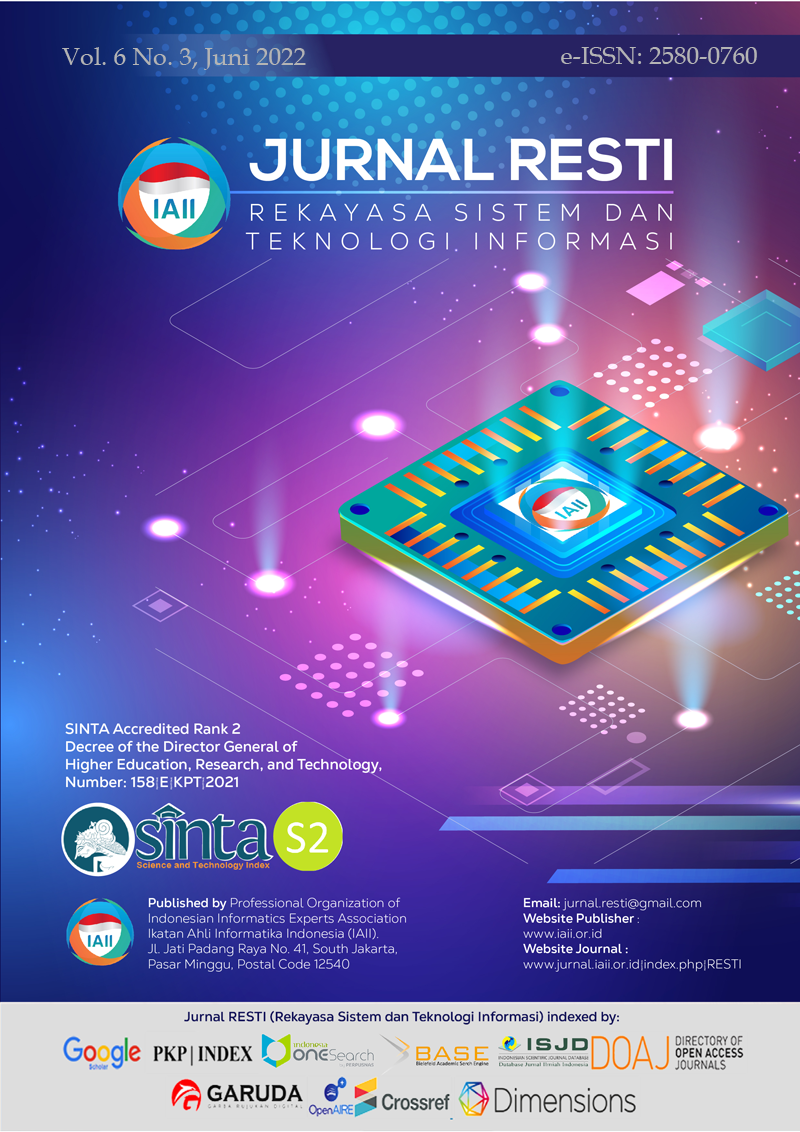Identification of Malaria Parasite Patterns With Gray Level Co-Occurance Matrix Algorithm (GLCM)
Abstract
The results of the test using 5 data of malaria parasite test imagery found that image 1 has an average accuracy value of the energy of 0.55627, homogeneity average of 0.8371, PSNR of 6.1336db, and MSE of 0.24358. Image 2 has an average energy accuracy value of 0.22274, an average Homonegity of 0.98532, a PSNR of 6.1336db, and an MSE of 0.24358. Image 3 has an energy average accuracy value of 0.28735, a Homonegity average accuracy value of 0.9793, a PSNR of 6.133db, and an MSE of 0.24358. Image 4 has an energy average accuracy value of 0.32907 and an average homogeneity accuracy value of 0.97073, PSNR 6.133db, and MSE 0.24358. Image 5 has an average accuracy value of 0.74102, Homonegity average of 0.99844, PSNR of 6.133db, and MSE of 0.4358. Image 6 has an accuracy value of 0.34758 energy, an average accuracy value of homogeneity of 0.99129, a PNSR of 6.133db, and an MSE of 0.24358. Obtained the rule if the average value of energy > = 0.50 then the pattern of malaria parasites is very clear, namely Image 1 and image 5 with a pattern of malaria parasites is very clear.
Downloads
References
K. K. R. Indonesia, “No Title.” http://p2p.kemkes.go.id/hari-malaria-sedunia-tahun-2021/.
A. News, “No Title”. https://www.antaranews.com/berita/2186930/parasit-malaria-bersembunyi-di-organ-limpa.
Kompas.com, “No Title.” https://www.kompas.com/tren/read/2021/04/27/110300865/kondisi-malaria-di-indonesia-dan-penanganan-pada-masa-pandemi-covid-19?page=all.
Beritasatu.com, “No Title.” https://www.beritasatu.com/dunia/764133/who-dukung-pemberantasan-malaria-di-25-negara#!
Y. Supranelfy, S. E. Warni, N. Inzana, and N. H. Suryaningtyas, “Penemuan Kasus Malaria Berdasarkan Pemeriksaan Mikroskopis di Kota Lubuklinggau dan Kabupaten Musi Rawas,” ASPIRATOR - J. Vector-borne Dis. Stud., vol. 10, no. 1, pp. 27–36, 2018, doi: 10.22435/asp.v10i1.15.
N. Y. Savera, “Stadium dan Tingkat Parasitemia Plasmodium Falciparum pada Sediaan Darah Malaria,” Jar. Lab. Medis, vol. 1, no. 1, p. 22, 2019, doi: 10.31983/jlm.v1i1.4948.
R. Rosnelly and J. Kusanti, Pengembangan Sistem Identifikasi Penyakit Malaria Berdasarkan Pengolahan Citra Digital. 2019.
N. Y. Savera, “Stadium dan Tingkat Parasitemia Plasmodium Falciparum pada Sediaan Darah Malaria,” Jar. Lab. Medis, vol. 1, no. 1, p. 22, 2019, doi: 10.31983/jlm.v1i1.4948.
L.Agustien, H. Armanto, and L. Zaman, “Ekstraksi Fitur (Bentuk dan Tekstur) Pada Sel Darah Merah Penduduk Indonesia Untuk Mengenali Spesies dan Fase Parasit Malaria,” Seminar Nasional Teknologi. dan Rekayasa, pp. 172–178, 2018.
S. Ratna, “Pengolahan Citra Digital Dan Histogram Dengan Phyton Dan Text Editor Phycharm,” Technol. J. Ilm., vol. 11, no. 3, p. 181, 2020, doi: 10.31602/tji.v11i3.3294.
N. Syahidan, S. Rati, S. Lubis, N. Fadillah, T. Informatika, and U. Samudra, “Terbit online pada laman web jurnal: https://ejurnalunsam.id/index.php/jitkom/ Klasifikasi Tanaman Aglaonema Dengan Fitur Ekstraksi Gray Level Co-Occurrence Matrix Dan K-Nearest NeighboR,” vol. 01, no. 02, 2020, [Online]. Available: https://ejurnalunsam.id/index.php/jitkom/.
Sumarni, “Penerapan Metode Iteratif Lanczos – Hybrid Regularization Pada Restorasi Citra Digital Hasil Scan,” J. Sisitem Komput. dan Inform., vol. 2, no. 1, pp. 1–5, 2020, doi: 10.30865/json.v2i1.2156.
Doni, “Implementasi Perbaikan Kualitas Citra Dengan Menggunakan Metode Lucy-Richardson,” Maj. Ilm. INTI,vol. 14, No.2, September, pp. 275–278, 2019.
I. W. A. Wijaya Kusuma and A. Kusumadewi, “Penerapan Metode Contrast Stretching, Histogram Equalization Dan Adaptive Histogram Equalization Untuk Meningkatkan Kualitas Citra Medis Mri,” Simetris J. Tek. Mesin, Elektro dan Ilmu Komput., vol. 11, no. 1, pp. 1–10, 2020, doi: 10.24176/simet.v11i1.3153.
A. Salsabila, R. Yunita, and C. Rozikin, “Identifikasi Citra Jenis Bunga menggunakan Algoritma KNN dengan Ekstrasi Warna HSV dan Tekstur GLCM,” Technomedia J., vol. 6, no. 1, pp. 124–137, 2021, doi: 10.33050/tmj.v6i1.1667.
Copyright (c) 2022 Jurnal RESTI (Rekayasa Sistem dan Teknologi Informasi)

This work is licensed under a Creative Commons Attribution 4.0 International License.
Copyright in each article belongs to the author
- The author acknowledges that the RESTI Journal (System Engineering and Information Technology) is the first publisher to publish with a license Creative Commons Attribution 4.0 International License.
- Authors can enter writing separately, arrange the non-exclusive distribution of manuscripts that have been published in this journal into other versions (eg sent to the author's institutional repository, publication in a book, etc.), by acknowledging that the manuscript has been published for the first time in the RESTI (Rekayasa Sistem dan Teknologi Informasi) journal ;








